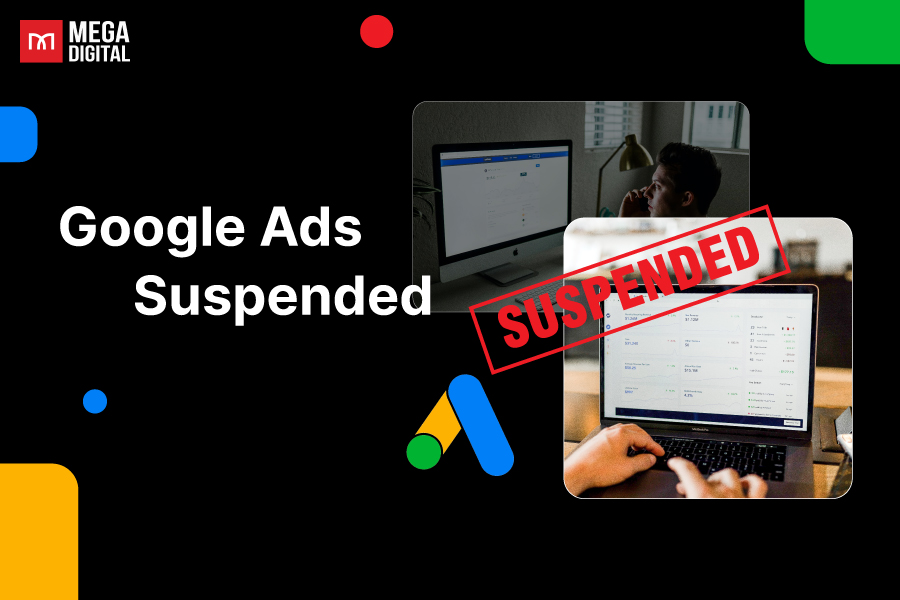In the world of digital marketing, understanding your metrics is key to evaluating the success of your campaigns. One such critical metric is the Click-Through Rate (CTR) in Google Ads. To enhance your outcomes with Google Ads, it’s essential to boost your click-through rate (CTR). In this article, we’ll delve into the concept of CTR Google Ads, its significance, and how to improve it.
What is CTR in Google Ads?
Click-through rate, commonly known as CTR, is not exclusive to Google Ads. It is a metric that measures the number of clicks advertisers receive on their ads per number of impressions. It’s a common metric for assessing the performance of an online advertising campaign targeting a specific website and also for evaluating the effectiveness of email campaigns.
In the context of Google Ads, CTR is used to gauge how well your keywords and ads are performing.
How to track CTR in Google Ads?
The first step is to log into your Google Ads account where all your campaigns are managed.
Once you’re logged in, click on the “Campaigns” tab on the left side of your dashboard. This will bring up an overview of all your campaigns.
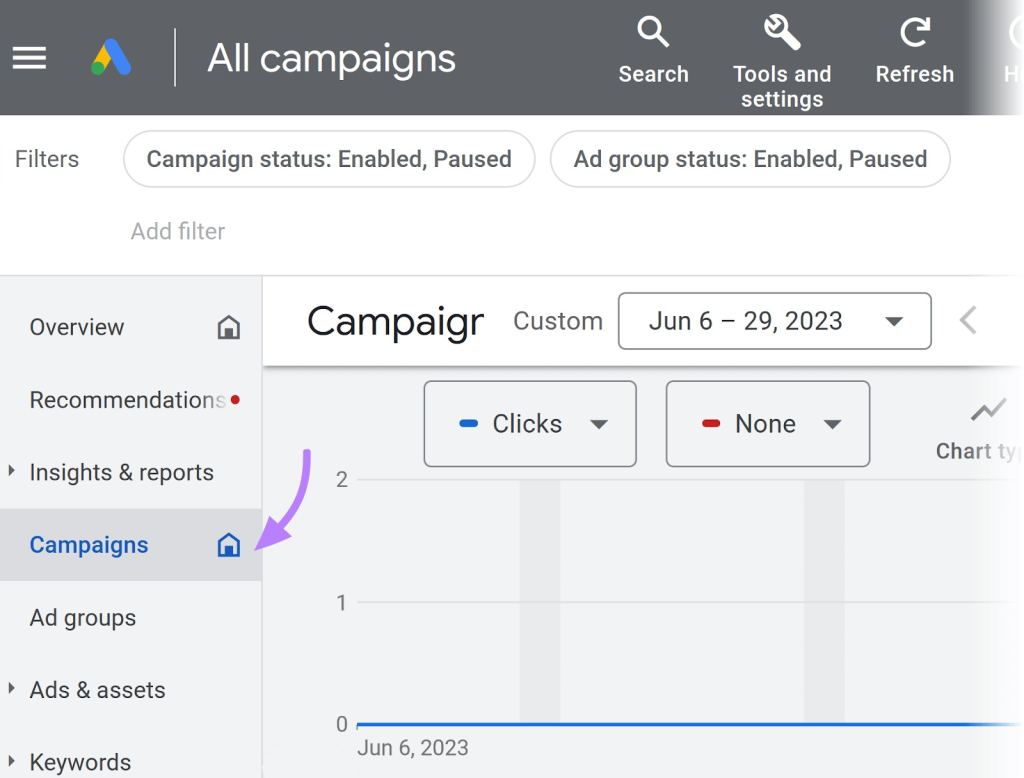
In the campaign overview, there’s a column labeled “CTR”. This column shows the CTR for each ad group in that particular campaign.
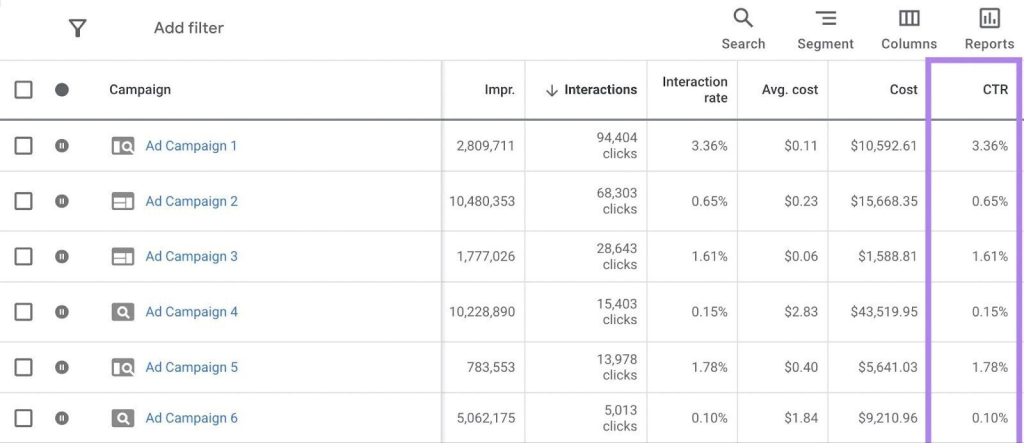
If you don’t see the CTR column, you can add it by modifying the column view.
CTR Formula in Google Ads
Google Ads CTR is calculated by dividing the number of clicks your ad receives by the number of times your ad is shown (impressions).
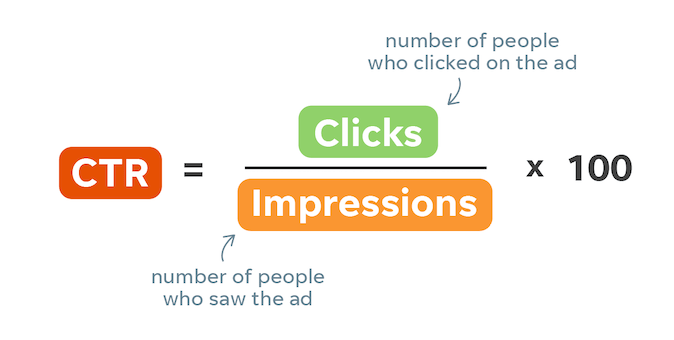
Example: Suppose you have an ad that has been shown 1,000 times (impressions) and it received 50 clicks.
Using the provided values in the formula:
CTR = 100050*100= 5
This calculation gives us a CTR of 5%. This indicates that out of every 100 instances your ad was displayed, it received 5 clicks.
Why is Google Ads CTR an Important Metric?
CTR is a good indication of how targeted your ads are. If you have a high CTR, it’s a good sign that your ads are reaching the right audience and your ad copy is relevant to their search queries. On the other hand, a low CTR might indicate that your ads are not compelling or relevant to the audience they’re being shown to.
A robust CTR is significant for various reasons:
Enhancing cost efficiency
A higher CTR implies that you’re maximizing the value of your advertising budget, especially if you’re paying for ads on a cost-per-click (CPC) basis.
Evaluating campaign performance
CTR serves as a metric to assess the effectiveness of individual ads, keywords, or entire campaigns. This analysis helps in determining what strategies work best for future campaigns.
Boosting Ad Rank
Your actual CTR influences your Google-predicted Expected CTR over time, impacting your Ad Rank. A higher Ad Rank translates to better ad positioning compared to competitors.
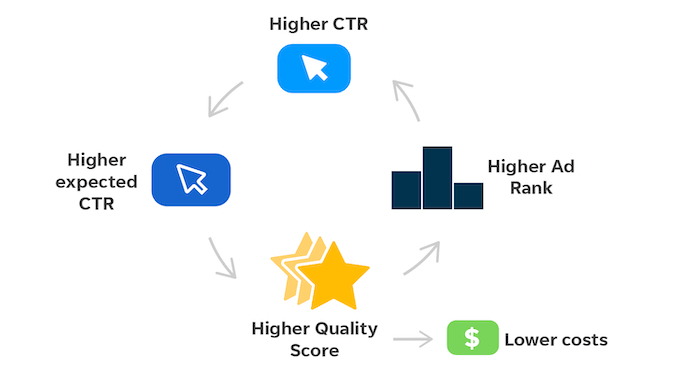
What is a Good CTR in Google Ads?
Since CTR is a vital metric in Google Ads, every advertiser wants to optimize their ad campaigns to achieve a good CTR. But what constitutes a “good” CTR in Google Ads?
The truth is, it depends. A good CTR for Google Ads is influenced by several factors including the industry you’re in, the competition, and the location of your target audience. However, across all industries, the average CTR in Google Ads is around 2%.
Click-through rates may vary based on the campaign, but generally, reaching a range of 4% to 5% is seen as favorable. Exceeding 10% indicates outstanding performance, indicating the effectiveness of your strategy. It’s recommended to reproduce successful methods to uphold or improve performance levels.
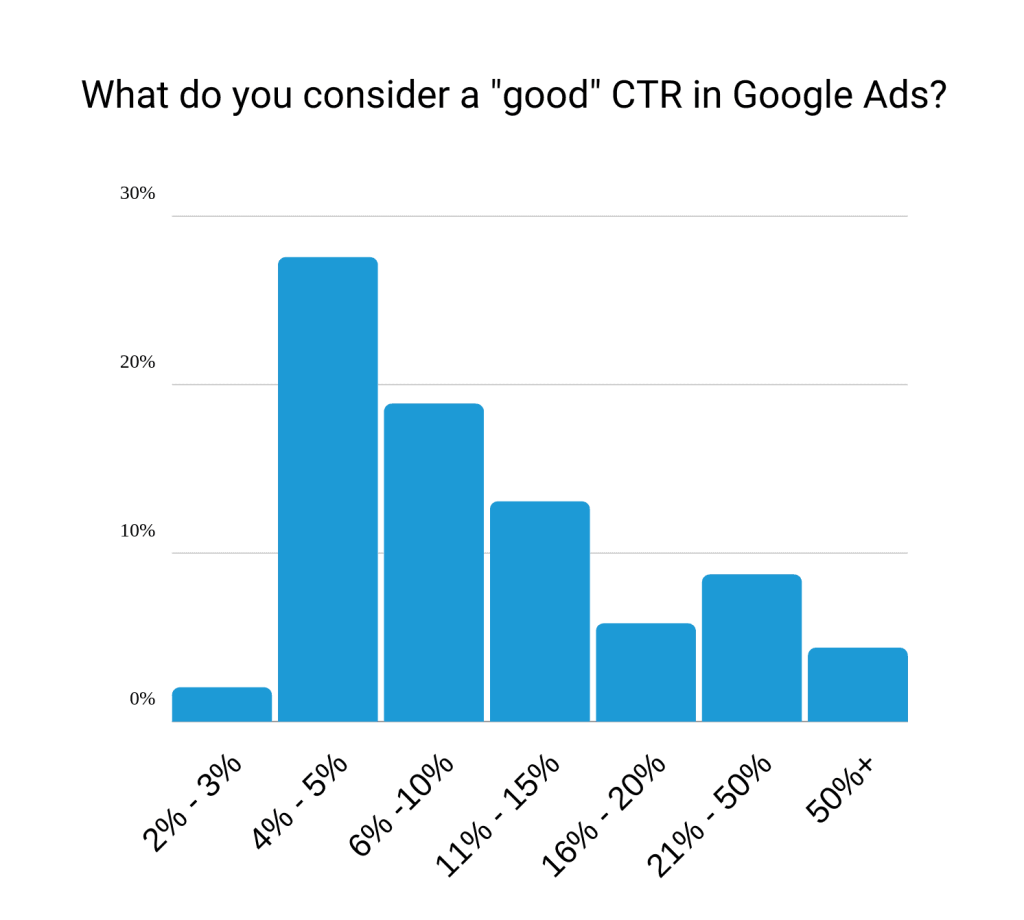
Sometimes, you may encounter click-through rates surpassing 50%, but such occurrences are uncommon. This level of performance is typically observed only in branded campaigns.
But let’s explore this in more detail:
- Search Network: The average CTR on the Search Network is higher, typically around 3-4%. This is because users are actively searching for keywords related to your ad, making them more likely to click.
- Display Network: The average CTR on the Display Network is lower, often under 1%. This is because users are not actively searching but come across your ads while browsing websites.
- Industry Variation: Some industries have higher average CTRs than others. For instance, the dating and personal industry tends to have a high CTR (around 6%), while legal services may see a lower CTR (around 1.35%).
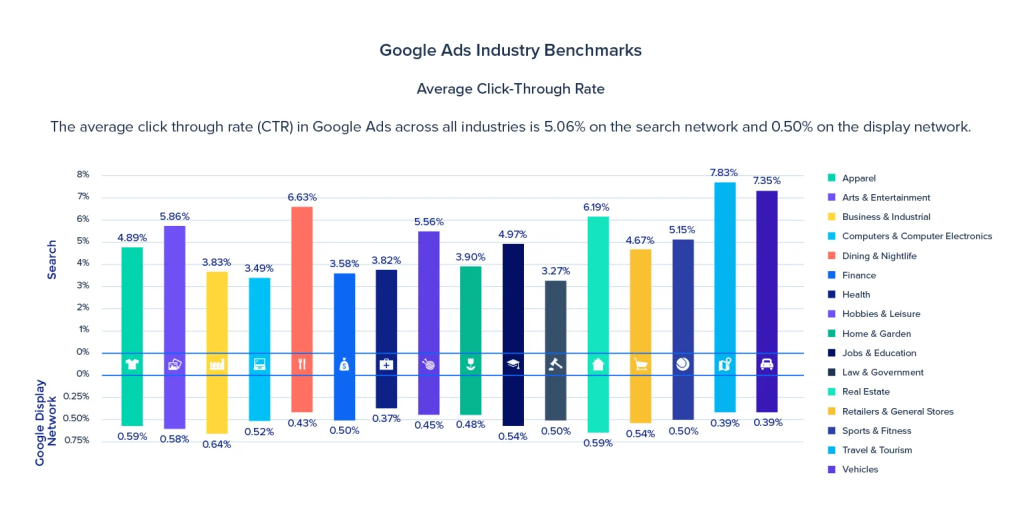
Remember, while having a high CTR is important, it’s not the only metric that matters. A high CTR with low conversions is not beneficial for your business. It’s essential to focus on the quality of your clicks, not just the quantity.
>>> Read more: Google Ads Benchmarks 2023 by Industry [Original & Latest data]
Is high CTR always good?
Keep in mind, in pay-per-click advertising, you’re charged for each click on your ad, and not every click will lead to a conversion. Thus, a high click-through rate can be detrimental if your conversion rate is low because you’re essentially paying for clicks that won’t generate a return on your investment.
Your objective isn’t solely to achieve the highest click-through rate but rather to attain the highest qualified click-through rate feasible.
Additionally, another crucial aspect to consider is the keywords you’re bidding on. Certain keywords may come with a hefty price tag, meaning that even if those clicks lead to conversions, your ad spend might not yield a return on investment. Ideally, you aim for a high click-through rate on keywords that are not only relevant but also affordable.
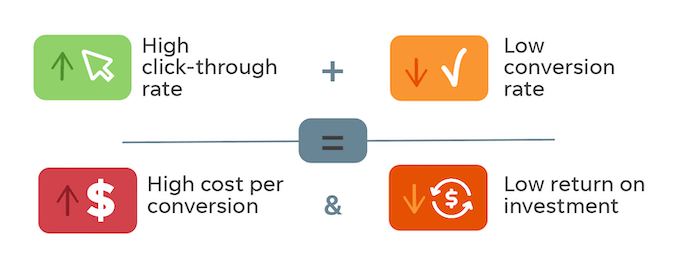
CTR Optimization: How to Improve CTR Google Ads?
Improving your CTR in Google Ads is a crucial part of optimizing your campaigns for success. Here are 7 strategies that will boost your CTR:
#1 Optimize your ad copy
The text of your ad is what communicates your message to your audience. It’s essential to ensure it is as engaging and pertinent as you can make it. Use persuasive language that speaks directly to the user’s needs and desires. Incorporate a concise call to action (CTA) that clearly instructs the user on the desired action. Incorporate your main keyword in the headline and display URL to make it clear that your ad is relevant to the user’s search.
A typical search advertisement consists of a headline and a description line, structured as follows:

How do you craft effective ad copy for your headlines and descriptions?
Utilize compelling language to emphasize distinctive selling points, and incorporate compelling calls to action (CTAs) to prompt users to engage with your ad by clicking on it.
For instance, let’s revisit ads associated with the keyword “dog food”:
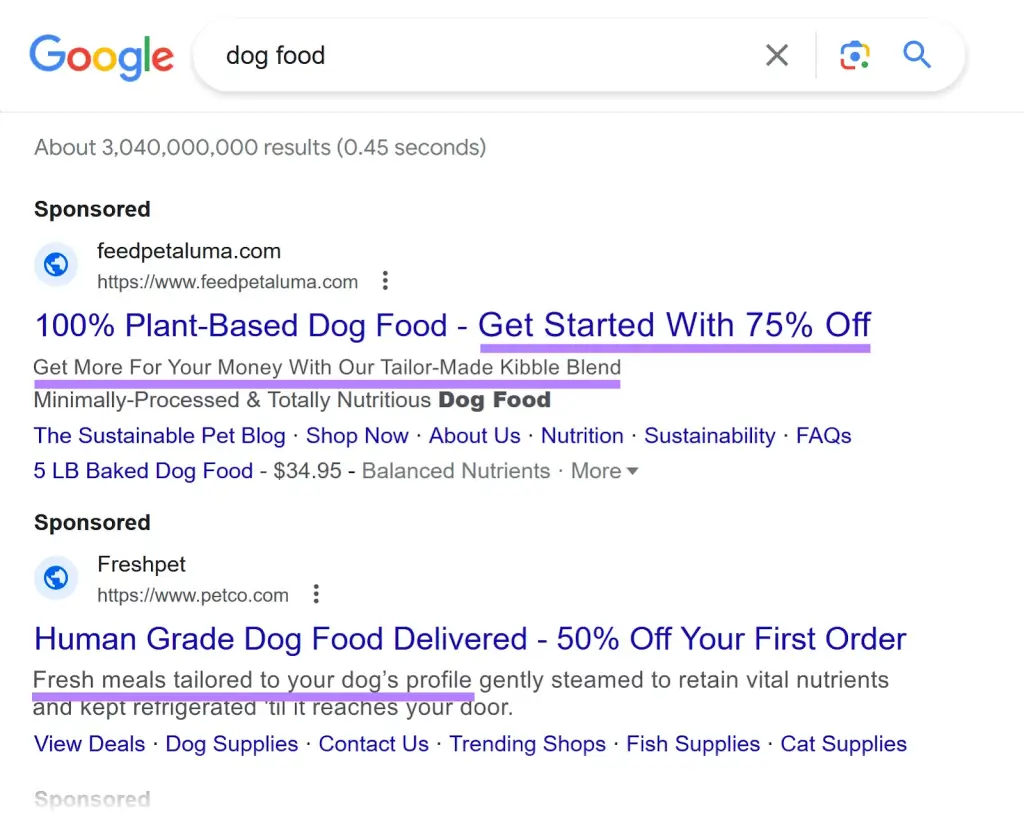
This type of language is crafted to motivate customers:
- “Start Now and Save 75%”
- “Customized Fresh Meals for Your Dog”
- “Maximize Value with Our Personalized Kibble Mix”
Such wording is instrumental in boosting an ad’s click-through rate (CTR).
#2 Use ad extensions
Ad extensions are supplementary details that you can append to your Google Ads. These can include additional links to specific pages on your site, business location, or phone number. They make your ad more informative and engaging, which can increase your CTR.
For example, Here’s an ad featuring sitelink extensions for the keyword “dog food”:

#3 Target your ads
Google Ads offers various targeting options that allow you to narrow down who sees your ads. You can target based on geographic location, device type, and even based on users’ interests and demographics. By ensuring your ads are seen by those most likely to be interested in your products or services, you can increase your CTR.
#4 Improve your quality score
Quality Score is a metric determining the quality and relevance of your ads and keywords. It’s influenced by your CTR, the relevance of each keyword to its ad group, landing page quality, and relevance, and the performance of your past ads. Increased Quality Score can result in elevated ad placements and reduced expenses.
#5 Test different ads
A/B testing is a powerful strategy for improving your Google Ads CTR. By creating multiple versions of your ad with different headlines, descriptions, and display URLs, you can test and see which version performs best. Google Ads will automatically show the better-performing ad more often.
#6 Use negative keywords
Keywords prompt the display of your ad. However, negative keywords are terms that you don’t want your ads to appear for. By adding negative keywords to your campaign, you can prevent your ads from showing on irrelevant searches, reducing wasted clicks and improving your CTR in Google Ads.
#7 Adjust bids for high-performing keywords
If certain keywords are driving a lot of valuable traffic to your site, you might want to increase your bids on these keywords. By bidding more, your ad is likely to appear in a higher position, which can increase your visibility and CTR.
Wrap-up
In conclusion, Google Ads CTR is more than just a metric; it’s a reflection of your ad’s relevance and appeal to your target audience. A good understanding of CTR Google Ads and the strategies to improve it can significantly enhance your ad performance, leading to better engagement and higher conversions.







